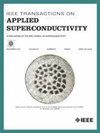Nb3Sn 超导磁体半长原型的淬火分析与实验
IF 1.7
3区 物理与天体物理
Q3 ENGINEERING, ELECTRICAL & ELECTRONIC
引用次数: 0
摘要
中国科学院近代物理研究所(IMP)正在为高强度重离子加速器(HIAF)建造第四代超导电子回旋共振离子源(FECR)中使用的 Nb3Sn 磁体。为了验证 Nb3Sn 超导磁体的技术,已经开发了一个半长的磁体原型,包括两个轴电磁线圈和一个带有冷铁轭的六极线圈。由于 Nb3Sn 导体的结构和特性十分复杂,需要淬火保护,这给磁体的建造带来了巨大挑战。为了应对这一挑战,我们使用 OPERA-Quench 和 STEAM-LEDET 进行了淬火模拟和实验。根据模拟结果,设计了一个保护电路,以确保磁体的安全。随后,通过一系列实验对保护电路进行了测试。然而,由于磁通跃迁引起的电压火花的干扰,一些淬火事件没有得到充分保护,导致磁体逐渐退化。在这些事件中,估计的绝热热点温度达到了 549 K,这可能是导致观察到的退化的原因。此外,使用 Metrosil 变阻器对淬火保护的影响也在研究之中。本文章由计算机程序翻译,如有差异,请以英文原文为准。
Quench Analysis and Experiments on Nb3Sn Superconducting Magnet Half-Length Prototype
The Institute of Modern Physics (IMP) at the Chinese Academy of Science (CAS) is building a Nb
3
Sn magnet for utilization in a fourth-generation superconducting electron cyclotron resonance ion source (FECR) for the High Intensity heavy ion Accelerator Facility (HIAF). A half-length prototype of the magnet, comprising two axis solenoid coils and a sextupole coil with a cold iron yoke, has been developed to validate the technology of the Nb
3
Sn superconducting magnet. The construction of the magnet presents a significant challenge due to the complex structure and properties of the Nb
3
Sn conductor, necessitating quench protection. To tackle this challenge, quench simulations and experiments were conducted using OPERA-Quench and STEAM-LEDET. Based on the simulation results, a protection circuit was designed to ensure the safety of the magnet. Subsequently, the protection circuit underwent testing through a series of experiments. However, some quench events were inadequately protected against due to interference from voltage sparks caused by flux jump, resulting in gradual degradation of the magnet. The estimated adiabatic hot-spot temperature during these events reached 549 K, which is likely responsible for the observed degradation. Additionally, the impact of the utilizing of Metrosil varistors on quench protection is also under investigation.
求助全文
通过发布文献求助,成功后即可免费获取论文全文。
去求助
来源期刊

IEEE Transactions on Applied Superconductivity
工程技术-工程:电子与电气
CiteScore
3.50
自引率
33.30%
发文量
650
审稿时长
2.3 months
期刊介绍:
IEEE Transactions on Applied Superconductivity (TAS) contains articles on the applications of superconductivity and other relevant technology. Electronic applications include analog and digital circuits employing thin films and active devices such as Josephson junctions. Large scale applications include magnets for power applications such as motors and generators, for magnetic resonance, for accelerators, and cable applications such as power transmission.
 求助内容:
求助内容: 应助结果提醒方式:
应助结果提醒方式:


